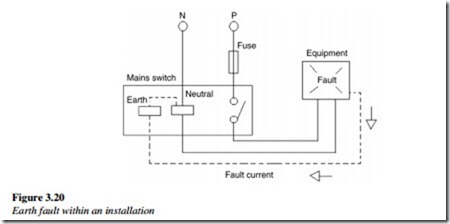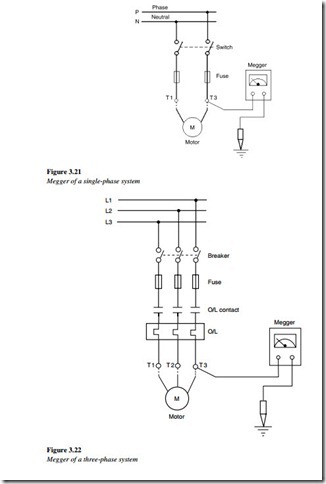Accurate wiring of circuits and connections
While troubleshooting electrical equipments, continuity tests of circuits and wiring are done by performing the following procedure:
• Checking correct polarity and ensuring that supply polarity follows the correct circuit route.
• Ensuring that there are no short-circuits in supply due to a wrong connection or termination of wires.
• Identifying different conductors before making connections to a device to ensure correctness of circuits and connections.
• Ensuring that there are no interconnections between two different circuits.
• Correctly identifying circuit loads such as contactors, relays, and their contacts.
• Identifying active conductors and their corresponding neutral conductors to check the integrity of the circuit.
A continuity test is particularly useful to help detect a short-circuit condition, which is a result of cross-linking of wires between two different circuits.
An interconnection between circuits is likely to be due to the following reasons:
• Incorrect termination of wires
• Result of insulation breakdown
• Incorrect connection at field junction box.
Figure 3.20 is an example of an electrical appliance connected with a supply system. If, due to any reason, a fault occurs within the appliance causing current flow in its body, the fault current flows back to the mains supply. The circuit shown here is a TN-C-S type of supply where the earth is derived from the supply neutral at the service entrance. In the case of other supply systems the earth lead may not be interconnected at service entrance but go right back to the source (TN-S). However the general principles are still valid.
It is required to conduct tests between neutral conductors of all other circuits and the active conductor of the same circuit at the mains supply distribution to reveal any interconnection faults.
Before conduction of tests, perform the following steps:
• Disconnect neutral link from circuit
• Keep circuit protective
• Close all contactors or switches.
Check all direct interconnections with the low-range ohmmeter. If resistance shown in the ohmmeter is very low then it indicates a short-circuit condition. Suppose, the load is connected with an active phase and is neutral from different circuits, then it can be detected only with connected loads. If these steps are performed prior to the start of the test, then check the resistance between the neutral and the active conductors.
To check for insulation resistance of cables, take insulation resistance with megger or insulation-resistance tester, especially if insulation breakdown is suspected. If the resistance shown is less than 1 MΩ then it can be said that the wiring or device terminal has an insulation problem.
To identify each electrical circuit and its active and neutral conductors, calculate load resistance with the ohmmeter and accordingly, identify each active and neutral conductor.
Conducting an insulation-resistance test:
To conduct an insulation-resistance test, perform the procedure listed below:
1. Check the insulation tester by shorting its test leads. It should show zero resistance. If test leads are kept open, it should show infinite resistance.
2. Isolate the section to be tested from the power supply.
3. Disconnect all lamps or electronic devices from the circuit to be tested.
4. Select the proper operating voltage for conducting the test, depending upon the rating of the system.
5. Check for connections while conducting tests so that only the section to be tested is included in the test.
6. There should not be any stray parallel leakage paths.
7. Check the instrument for pointer index or any other pre-adjustment necessary.
8. Test leads to be used should have good-quality insulation.
9. Before starting the test, insure that all the capacitors in the circuit are discharged by shorting their two leads together. Similarly, after the test
ensure that they are in discharge condition. If this is not done they may give false readings.
10. Before touching cable ends after testing, discharge any energy that might have been stored in the cables during the test. This is most likely to occur in long runs of larger cables due to their capacitance.
11. Checking continuity of an earthing system requires the use of low-reading ohmmeters, which should be zero-adjusted before each test and calibrated on regular intervals.
12. Where the testing of the earth electrode resistance is required (i.e., the resistance between the electrode and the general mass of earth), one of the special types of earth-resistance testers must be used.
Optional tests
There still remain a few useful tests using the measuring devices.
These tests are used for checking single- or three-phase systems and other electrical devices. Some of the tests we have discussed in the next few sections. These can be used
to strengthen troubleshooting techniques.
(a) Megger testing cables and auxiliary devices of a single-phase system Disconnect P and N from the supply side, as well as from the other end.
Now we have isolated our test circuit, making it dead. Short P and N with a temporary short link. Close switch and protection devices.
As shown in Figure 3.21, open motor terminals, so that the motor remains isolated from the test circuit. Check resistance with the insulation tester between the neutral link and earth. If the value shown in the meter is less than 1 MΩ, then there is a fault with either the cable insulation or device terminals.
(b) Megger testing cables and auxiliaries of a three-phase system
Disconnect L1, L2, and L3 from the supply side, as well as from the other end. This makes it a dead circuit.
Short L1, L2, and L3 terminals with a temporary link. Close the breaker device and protection devices. As shown in Figure 3.22, open motor terminals T1, T2, and T3, so that the motor remains isolated from the test circuit.
Check resistance with insulation tester between each conductor and earth.
If the meter shows a low value less than 1 MΩ, there is a fault in either cable insulation or device terminals.
(c) Megger testing of motor
A pre-condition for megger testing of a motor is to isolate the motor from the supply totally. Take the megger value of a motor between each conductor and earth, as shown in Figure 3.23, to check the earthing of the stator winding. This will help us to conclude on earthing status of the stator winding. Similarly, check for shorting between two windings by checking the megger value between two stator-winding terminals, as shown in Figure 3.24.
Thus, a low reading can identify insulation failure of any winding inside the motor.
Fault finding on an underground cable
Generally, underground cables are prone to insulation failure, although due care is taken. Since they are buried underground, it is difficult to exactly pinpoint the fault location. Resistance values between earth and a conductor from the two ends can be checked. If the value reduces drastically, then the faulty location can be isolated.

